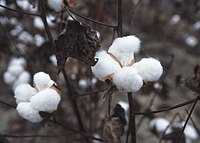
Nitric oxide‐enhanced Shiga toxin production was regulated by Fur and RecA in enterohemorrhagic Escherichia coli O157
Sign Up to like & getrecommendations! Published in 2017 at "MicrobiologyOpen"
DOI: 10.1002/mbo3.461
Abstract: Enterohemorrhagic Escherichia coli (EHEC) produces Shiga toxin 1 (Stx1) and Shiga toxin 2 (Stx2). Nitric oxide (NO), which acts as an antimicrobial defense molecule, was found to enhance the production of Stx1 and Stx2 in… read more here.
Keywords: production; shiga toxin; enterohemorrhagic escherichia; concentration ... See more keywords

Comparison of NheA toxin production and doubling time between Bacillus cereus and Bacillus thuringiensis
Sign Up to like & getrecommendations! Published in 2017 at "Applied Biological Chemistry"
DOI: 10.1007/s13765-017-0308-6
Abstract: In this study, we compared the toxin gene expression, NheA toxin production, doubling time, and viable cell number for several strains of the food poisoning bacteria Bacillus cereus and the microbial pesticide Bacillus thuringiensis. The… read more here.
Keywords: thuringiensis; nhea toxin; doubling time; toxin ... See more keywords

Impact of deoxycholate on Clostridioides difficile growth, toxin production, and sporulation
Sign Up to like & getrecommendations! Published in 2020 at "Heliyon"
DOI: 10.1016/j.heliyon.2020.e03717
Abstract: Purpose Bile acids play an important role in Clostridioides difficile life cycle. Deoxycholate (DCA), one of the most abundant secondary bile acids, is known to inhibit vegetative growth and toxin production. However, limited data are… read more here.
Keywords: growth toxin; sporulation; growth; toxin production ... See more keywords

Cytolytic toxin production by Staphylococcus aureus is dependent upon the activity of the protoheme IX farnesyltransferase
Sign Up to like & getrecommendations! Published in 2017 at "Scientific Reports"
DOI: 10.1038/s41598-017-14110-8
Abstract: Staphylococcus aureus is a medically important pathogen with an abundance of virulence factors that are necessary for survival within a host, including the production of cytolytic toxins. The regulation of toxin production is mediated by… read more here.
Keywords: cytolytic toxins; staphylococcus aureus; production; protoheme farnesyltransferase ... See more keywords

Genetic association of toxin production in the dinoflagellate Alexandrium minutum
Sign Up to like & getrecommendations! Published in 2022 at "Microbial Genomics"
DOI: 10.1099/mgen.0.000879
Abstract: Dinoflagellates of the genus Alexandrium are responsible for harmful algal blooms and produce paralytic shellfish toxins (PSTs). Their very large and complex genomes make it challenging to identify the genes responsible for toxin synthesis. A… read more here.
Keywords: alexandrium minutum; ability produce; toxin production; toxin ... See more keywords

Spo0A Suppresses sin Locus Expression in Clostridioides difficile
Sign Up to like & getrecommendations! Published in 2020 at "mSphere"
DOI: 10.1128/msphere.00963-20
Abstract: Clostridioides difficile is the leading cause of antibiotic-associated diarrheal disease in the United States. During infection, C. difficile spores germinate, and the vegetative bacterial cells produce toxins that damage host tissue. In C. difficile, the… read more here.
Keywords: expression; sporulation; toxin production; locus ... See more keywords

Effects of stochasticity and division of labor in toxin production on two-strain bacterial competition in Escherichia coli
Sign Up to like & getrecommendations! Published in 2017 at "PLoS Biology"
DOI: 10.1371/journal.pbio.2001457
Abstract: In phenotypically heterogeneous microbial populations, the decision to adopt one or another phenotype is often stochastically regulated. However, how this stochasticity affects interactions between competing microbes in mixed communities is difficult to assess. One example… read more here.
Keywords: toxin production; division labor; competition; toxin ... See more keywords

Assessment of the Appearance and Toxin Production Potential of Invasive Nostocalean Cyanobacteria Using Quantitative Gene Analysis in Nakdong River, Korea
Sign Up to like & getrecommendations! Published in 2022 at "Toxins"
DOI: 10.3390/toxins14050294
Abstract: Invasive nostocalean cyanobacteria (INC) were first reported in tropical regions and are now globally spreading rapidly due to climate change, appearing in temperate regions. INC require continuous monitoring for water resource management because of their… read more here.
Keywords: quantitative gene; toxin production; production potential; toxin ... See more keywords

The Influence of Micronutrient Trace Metals on Microcystis aeruginosa Growth and Toxin Production
Sign Up to like & getrecommendations! Published in 2022 at "Toxins"
DOI: 10.3390/toxins14110812
Abstract: Microcystis aeruginosa is a widespread cyanobacteria capable of producing hepatotoxic microcystins. Understanding the environmental factors that influence its growth and toxin production is essential to managing the negative effects on freshwater systems. Some micronutrients are… read more here.
Keywords: growth; toxin production; growth toxin; microcystis aeruginosa ... See more keywords

Growth, Toxin Content and Production of Dinophysis Norvegica in Cultured Strains Isolated from Funka Bay (Japan)
Sign Up to like & getrecommendations! Published in 2023 at "Toxins"
DOI: 10.3390/toxins15050318
Abstract: The successful cultivation of Dinophysis norvegica Claparède & Lachmann, 1859, isolated from Japanese coastal waters, is presented in this study, which also includes an examination of its toxin content and production for the first time.… read more here.
Keywords: growth; toxin production; toxin; production ... See more keywords